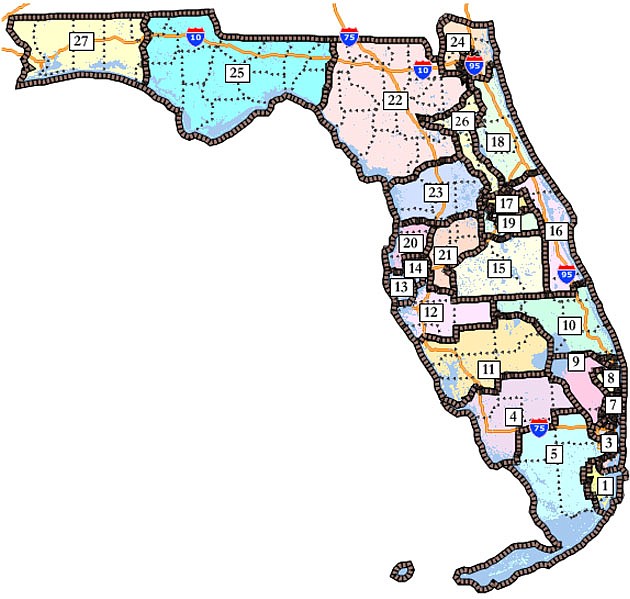- November 21, 2024
-
-
Loading

Loading

The above image shows Columbia University law student Nicholas Ortiz' proposed redistricting for Florida. Click here to download a map of current Florida districts.
When congressional district lines get redrawn next January based on the 2010 Census data, U.S. Rep. Vern Buchanan, R-Longboat Key, and Sen. President Pro-tempore Mike Bennett, R-Bradenton, could end up facing each other in the 2012 election. That would be the situation for the two power-brokers if the new boundary lines end up looking like what Columbia University law student Nicholas Ortiz has proposed.
Juris Doctorate candidate Ortiz recently finished the onerous congressional redistricting task that Florida lawmakers just began. The work is based largely on the 2010 U.S. Census population for Florida of roughly 18.8 million. Ortiz's challenge was to draw 27 districts instead of the current 25, each with the same population of about 696,345.
In doing that, Ortiz applied “traditional districting principles” — essentially meaning contiguous, compact and of equal population — in creating the scheme intended to comply with the complex and sometimes conflicting legal requirements.
“I sought to draw a map that reflects how I believe Florida divides geographically and culturally,” writes Ortiz in a 28-page memo in which he explains his redistricting plan.
Except for a recent three months when he lived in downtown Miami, Ortiz lived in Fruit Cove, a suburb of Jacksonville in St. Johns County for 13 years.
Ortiz worked under the direction of Columbia University School of Law professor Nate Persily, a redistricting expert whom courts relied on to redraw lines in four states following the 2000 Census.
Using state-of-the-art software to develop the new district boundaries, Ortiz applied the federal Voting Rights Act and state constitutional requirements to come up with the maps for Florida's 27 seats. In the detailed legal analysis, Ortiz explains his rationale for drawing the lines where he did to meet the sometimes conflicting criteria of state and federal laws.
Given that Ortiz's plan for District 12 would pit Bennett against fellow Republican and incumbent Buchanan, Bennett says, “I think Vern ought to move out, don't you?” While Bennett believes he would do better than Buchanan in southern Hillsborough if not also Manatee County, Bennett says he's open to moving south into the new District 11 that includes south Sarasota County, northern Lee, most of Highlands and all of Charlotte, DeSoto and Glades counties.
In an email, Buchanan only comments: “There will be no shortage of ideas or maps between now and next year. We're going to let the process work.”
For Bennett, moving south could work out nicely because the current representative for much of that new district, U.S. Rep. Tom Rooney, R-Tequesta, doesn't live there.
Rooney represents the current 16th district that runs from the Gulf to the Atlantic but lives on the east coast. U.S. Rep. Connie Mack, R-Fort Myers, lives just south of Ortiz's District 11.
Buchanan currently represents District 13, covering Manatee, Sarasota, DeSoto and Hardee counties, and a piece of Charlotte County. But both Buchanan, who lives on the south end of Longboat Key, and Bennett, who lives in southwest Bradenton, reside within the boundaries the new District 12. That district includes part of southwest Hillsborough, all of Manatee and Hardee counties and northern Sarasota County.
In Ortiz's plan, U.S. Rep. Kathy Castor, D-Tampa, won't have her current District 11 stretch across Tampa Bay to pick up a predominantly black community in south St. Petersburg or dip down to pick up parts of Palmetto and Bradenton.
Ortiz's proposed District 14 is more compact in keeping with one of the key new requirements of the state constitution. The new district boundaries are entirely within Hillsborough County, including Tampa and the near suburbs directly north.
Fort Myers and Naples get split into separate districts that extend inland, and eastern Collier gets lumped in with the Everglades and the Florida Keys. Northern Pinellas would become part of a district with most of Pasco County and southern Hernando County, and another district includes part of Hillsborough, Pasco, Polk, Lake and Sumter counties.
Legislators are tasked with drawing their own district boundaries. Both redistricting efforts are expected to end up with courts deciding where some lines are drawn, but Ortiz's work could now factor into those decisions.
The Legislature already set aside $30 million anticipating litigation after it approves the redistricting in January. The federal law mandates that the needs of minority populations factor into how the boundaries are drawn to ensure some level of minority representation in Congress, so that could be a target for challengers. Ortiz maintains he designed his plan to meet those requirements.
Perhaps just as important — because the state constitution requires that “No apportionment plan or district shall be drawn with the intent to favor or disfavor a political party or an incumbent ... ” — Ortiz claims the plan is apolitical. “I did not utilize political data in constructing my proposed districts,” he writes.